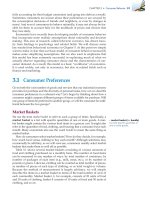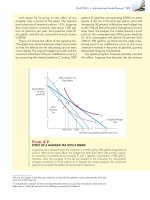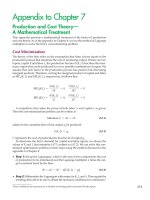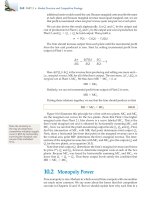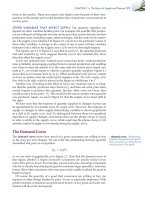(8th edition) (the pearson series in economics) robert pindyck, daniel rubinfeld microecon 47
Bạn đang xem bản rút gọn của tài liệu. Xem và tải ngay bản đầy đủ của tài liệu tại đây (118.38 KB, 1 trang )
22 PART 1 • Introduction: Markets and Prices
both to domestic and international macroeconomic fluctuations and to the
effects of government interventions. We will try to convey this understanding
through simple examples and by urging you to work through some exercises at
the end of the chapter.
2.1 Supply and Demand
The basic model of supply and demand is the workhorse of microeconomics. It
helps us understand why and how prices change, and what happens when the
government intervenes in a market. The supply-demand model combines two
important concepts: a supply curve and a demand curve. It is important to understand precisely what these curves represent.
• supply curve Relationship
between the quantity of a good
that producers are willing to sell
and the price of the good.
The Supply Curve
The supply curve shows the quantity of a good that producers are willing to sell
at a given price, holding constant any other factors that might affect the quantity
supplied. The curve labeled S in Figure 2.1 illustrates this. The vertical axis of the
graph shows the price of a good, P, measured in dollars per unit. This is the price
that sellers receive for a given quantity supplied. The horizontal axis shows the
total quantity supplied, Q, measured in the number of units per period.
The supply curve is thus a relationship between the quantity supplied and
the price. We can write this relationship as an equation:
QS = QS(P)
Or we can draw it graphically, as we have done in Figure 2.1.
Note that the supply curve in Figure 2.1 slopes upward. In other words, the
higher the price, the more that firms are able and willing to produce and sell. For
example, a higher price may enable current firms to expand production by hiring extra workers or by having existing workers work overtime (at greater cost
to the firm). Likewise, they may expand production over a longer period of
time by increasing the size of their plants. A higher price may also attract new
Price
S
F IGURE 2.1
THE SUPPLY CURVE
The supply curve, labeled S in the figure, shows how the quantity of a good offered for sale changes as the price of the good
changes. The supply curve is upward sloping: The higher the
price, the more firms are able and willing to produce and sell.
If production costs fall, firms can produce the same quantity at
a lower price or a larger quantity at the same price. The supply
curve then shifts to the right (from S to S’).
P1
P2
Q1
Q2
Quantity
S′

